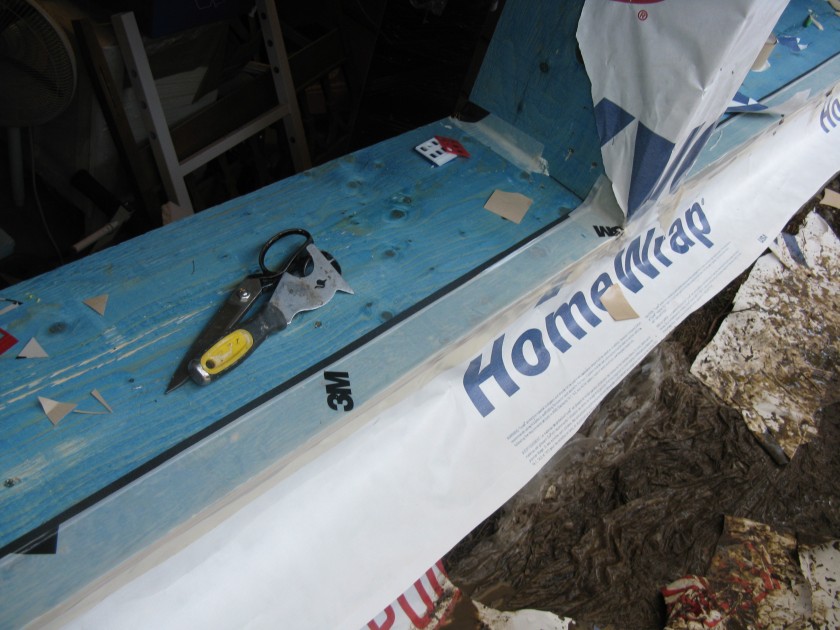
These are the two of the most commonly available house wraps available at your big box stores. Although both products are weather resistive barriers (WRB) made from spun bonded-polyolefin method (SBPO), they have a slightly different construction, and therefore different considerations when choosing your house wrap for window openings. There are various types of WRBs which include different features to help you make your choice, but there are also some unpublished or unspoken qualities which make one product better than the other for a particular window installation application, and we will examine these qualities in this article.
The technical background
Tyvek homewrap, made by DuPont:
Polyethylene fibers are fuzed together to form a single material layer membrane.
Permanence: Canada: PERM rating of 30 (1720 ng/Pa S m2) United States: PERM rating of 58 (3320 ng/Pa S m2). 4 months UV exposure max
Can easily break down if your siding or window frames are made with cedar as surfactants are released from the surface and break down the Tyvek material.
This product made by Dupont is the most well known brand name and will charge a premium to use their products.
Typar housewrap, by Polymer Group Inc
Two layer polypropylene fibers with a surface film
Permanence: PERM rating of 11.7 (670 ng/Pa S m2). 6 months UV exposure max
Surfactant and UV resistance, but by how much?
Permanence
I should note, that the real ideal permanence rating depends on the rest of the building enclosure components, indented application, location and weather. In trade literature, both companies claim that their product lies within the ideal performance range. I would like to cut through the marketing to give you the truth.
In theory, the highest permanence material in a cold climate should be ideal, in this case Tyvek. The reason for this is that the WRB is not a primary vapour diffusion control layer, so the least amount of moisture control you induce is the best choice. But in many cases, when I hygrothermally simulated walls in a computer program in various projects, I found the difference of moisture in a wall is usually negligible between the two. In a standard wood framed home with drained and vented cladding, either product will work fine. It is when your building enclosure is slightly different to the norm such as superinsulation, or other non-wood frame buildings is where these numbers seem to matter more. Although I would use Tyvek given the choice, Typar is just as acceptable for our window.
Advantage: Either WRB (depending on application)
Building codes and cedar surfactant release
In some jurisdictions treated lumber is required for window sills. Something I personally think needs to be refined as the lumber frame is neither exclusivity interior or exterior components. Many pressure treated lumber products such as the standard, cheapest ACQ (yellow/green stuff) should never be used indoors. It can have a negative impact on indoor air quality. So you may think, what are my alternatives? Cedar is the first wood that comes to mind, expensive but easily attainable and okay to use indoors. The big draw back is that it can eat away at your WRB due to a chemical incompatibility. Typar advertises that it has resistance to this effect. How well that resistance performs, I don’t know. There are many other wood treatment companies on the market that are made with environmentally sensitivity in mind such as Timbor or MicroPro Sienna, or heat treated lumber. In the old days, people used to paint the frames with white alkyd paint. It seemed to work well.
Are you using cedar shims to level your window? That is chemically incompatible with your SBPO. Time to switch to a composite shim or setting blocks.
Advantage: Either (Typar in special applications)
Folding memory and tear strength of WRB
One quality in which Tyvek has a disadvantage over Typar, is that Tyvek has folding memory. What I mean by this, is during the normal process of install the membranes are always folded back and forth before they reach their final position, especially on a windy day. The final result, is that the Tyvek Homewrap material can begin to resemble a crumpled up piece of paper. Now try to picture using that crumpled up Tyvek and pulling it taught to achieve uniform adhesion when taping joints. It is difficult to do so and takes up a lot more time to try and get it right. Most contractors use staples to adhere WRBs to the substrate. These stapes create holes in your new membrane, and I did see that the Typar definitely had better tear resistance which can potentially reduce driving rain to the interior. The Tyvek staples tended to cut the WRB more and create larger holes in your drainage plane. Not so good. If you use different fasteners with a gasket or flash tape each staple (PITA) and a little OCD. This is one of the biggest issues with Tyvek. For this reason, Typar was preferred by my local window installer.
Advantage :Typar
Flashing your WRB
This quality is probably the most important category in this article. If your sheets of WRB do not adhere well together, and don’t terminate well to other building materials, your WRB effectiveness is severely reduced.
If you are using flashing tape provided by your WRB manufacturer or Tuck Tape, the adhesive layer is really thin, and doesn’t have the best long term adhesion properties. Tyvek is a relatively flat uniform surface, where Typar is a little bit bumpy. This bumpy layer makes it difficult to get good adhesion with the tape. If you don’t use a j-roller or aggressively push down the tape on the tyvek, uniform adhesion coupled with a thin adhesive layer can encourage water to way-find its way through the joint. Since Tyvek is more flat, it is easier to get a better bond. With these tapes, it is sometimes possible to lift up the tape to reposition it on Tyvek, Sometimes a few fibers will break and can be okay as long as it is covered with a new piece of tape. But with typar, the white finishing layer rips off much easier.
This whole problem of flashing tapes can be solved by using a better quality flashing tape with a thicker adhesion layer. 3M 8067 / 3M3015 flashing tape or some made by SIGA, Tescon, or Vycor can solve these issues with an added expense. I would say that in window and door openings when using WRB, these tapes are a must, where the rest of the house, you can get away with tuck tape if it is applied with care.
Advantage: Tyvek (using manufactured supplied or Tuck tape)
Chemical compatibility with sealants under the flange
Knowing that VOCs can cause issues with WRBs, I made the assumption that a low-voc content polyurethane would work better than one with a higher content. I called the manufacture of the sealant who’s technical person said to me that they were compatible. This information was good enough for me at the time. They were not! Lesson learned, always do a test bead and let it set for a few days on your WRB. Chemically incompatible materials will never set properly and can become mushy. On the reinstall, I used DOW Corning 758 which is a silicone specifically made for compatibility with WRB, foams and plastics.
Sill pan
There are many different ways to flash a sill, including flex wrap products, self-adhered membranes, tapes, and plastic pans. A WRB is not a sill pan material as standing water can get through (over time).
Update:
Here is an interesting test done my Matt Risinger for JLConline, showing other budget housewraps with pin perforations. The results are dramatic, but scientifically questionable. In the example in the video, the weight of a glass of water on the membrane could represent a material that is close to fully adhered. In a real world scenario an airspace would not trap water like a piece of glass would. The amount of time the water is in contact with that barrier would be less as the water drains to the ground.. If this test was to test an air space behind cladding, the results would be different. Most importantly, this test only proves that these SBPO materials are not meant to be used as a sill pan material which the glass jar test emulates. Dupont makes a SBPO specifically for a stucco application which could imply that his test really tells us that budget housewraps are not meant for stucco.
http://www.jlconline.com/building-envelope/is-tyvek-worth-the-price-_o.aspx?dfpzone=general&utm_source=newsletter&utm_content=jump&utm_medium=email&utm_campaign=JLCNL_051514&day=2014-05-15
- For standard wood construction, permanence values should not be a deciding factor on which product to use. For standard 2″x6″ construction assemblies, in most cases hygrothermal simulations that I performed myself have shown that there was a negligible difference between the two in this category.
- Folding memory WRBs can be an issue and more difficult to tape and tears easier
- Use only quality flashing tape around the window and all other openings.
- Always check chemical compatibility of your sealant and your WRB a week before the install if you decide to go down that route rather than using flashing tape which is much better if applied properly.
- Housewrap WRBs should not be substituted as a still pan material.

